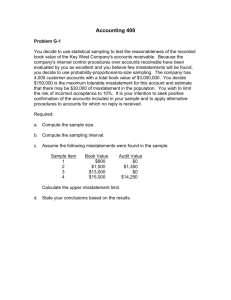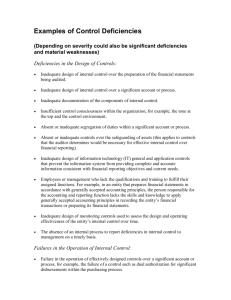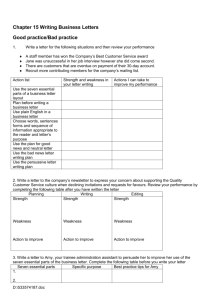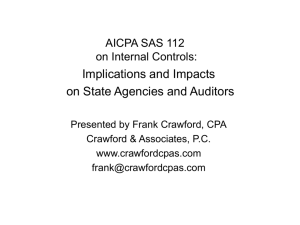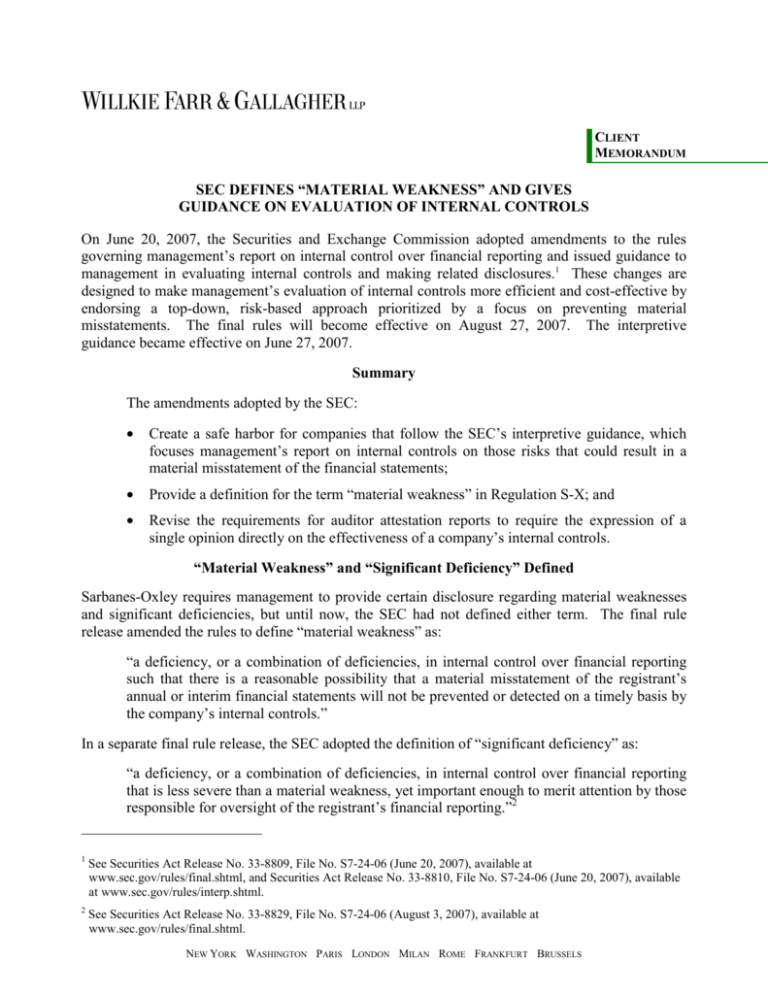
CLIENT
MEMORANDUM
SEC DEFINES “MATERIAL WEAKNESS” AND GIVES
GUIDANCE ON EVALUATION OF INTERNAL CONTROLS
On June 20, 2007, the Securities and Exchange Commission adopted amendments to the rules
governing management’s report on internal control over financial reporting and issued guidance to
management in evaluating internal controls and making related disclosures.1 These changes are
designed to make management’s evaluation of internal controls more efficient and cost-effective by
endorsing a top-down, risk-based approach prioritized by a focus on preventing material
misstatements. The final rules will become effective on August 27, 2007. The interpretive
guidance became effective on June 27, 2007.
Summary
The amendments adopted by the SEC:
•
Create a safe harbor for companies that follow the SEC’s interpretive guidance, which
focuses management’s report on internal controls on those risks that could result in a
material misstatement of the financial statements;
•
Provide a definition for the term “material weakness” in Regulation S-X; and
•
Revise the requirements for auditor attestation reports to require the expression of a
single opinion directly on the effectiveness of a company’s internal controls.
“Material Weakness” and “Significant Deficiency” Defined
Sarbanes-Oxley requires management to provide certain disclosure regarding material weaknesses
and significant deficiencies, but until now, the SEC had not defined either term. The final rule
release amended the rules to define “material weakness” as:
“a deficiency, or a combination of deficiencies, in internal control over financial reporting
such that there is a reasonable possibility that a material misstatement of the registrant’s
annual or interim financial statements will not be prevented or detected on a timely basis by
the company’s internal controls.”
In a separate final rule release, the SEC adopted the definition of “significant deficiency” as:
“a deficiency, or a combination of deficiencies, in internal control over financial reporting
that is less severe than a material weakness, yet important enough to merit attention by those
responsible for oversight of the registrant’s financial reporting.”2
1
See Securities Act Release No. 33-8809, File No. S7-24-06 (June 20, 2007), available at
www.sec.gov/rules/final.shtml, and Securities Act Release No. 33-8810, File No. S7-24-06 (June 20, 2007), available
at www.sec.gov/rules/interp.shtml.
2
See Securities Act Release No. 33-8829, File No. S7-24-06 (August 3, 2007), available at
www.sec.gov/rules/final.shtml.
NEW YORK WASHINGTON PARIS LONDON MILAN ROME FRANKFURT BRUSSELS
Safe Harbor for Evaluations Under New Guidance
In 2003, the SEC adopted rules requiring management to report on the company’s internal controls
and include that report in the company’s 10-K. Since that time, issuers and the accounting
profession have developed policies and procedures for preparing such reports that have proven to be
burdensome and time-consuming in practice. The SEC has now offered interpretive guidance
focusing on a top-down approach and a safe harbor for companies that follow it that is intended to
make the review process more cost-effective.
The guidance allows companies to focus their efforts on those areas that management identifies as
posing the greatest risks that material misstatements in the financial statements will not be
prevented or detected on a timely basis. The approach is a risk-based, top-down approach, in
contrast to a “bottom-up” approach requiring identification and review of every control regardless
of the potential to materially affect reported financial results. For example, if management
determines that a risk of a material misstatement is adequately addressed by an entity-level control,
no further evaluation of other controls is required.
The term “entity-level controls” refers to internal control that have a pervasive effect on the entity’s
system of internal control such as controls related to the control environment (for example,
management’s philosophy and operating style, integrity and ethical values; board or audit
committee oversight; and assignment of authority and responsibility); controls over management
override; the company’s risk assessment process; centralized processing and controls, including
shared service environments; controls to monitor results of operations; controls to monitor other
controls, including activities on the internal audit function, the audit committee, and self-assessment
programs; controls over the period-end financial reporting process; and policies that address
significant business control and risk management practices.
Following the new guidance gives companies a “safe harbor” under the Exchange Act, but since the
SEC recognizes that there are many other ways for management to conduct an appropriate
evaluation under Regulation S-X, compliance with the new guidance remains voluntary.
Management’s Evaluation Process
The guidance is organized around two principles:
•
First, management must identify risks to reliable financial reporting and evaluate
whether controls exist to address them.
•
Second, management must evaluate evidence about the operation of the identified
controls, based on its assessment of risk.
In both steps, management may limit its evaluation to the issues that pose the most serious and
substantial risks of a material misstatement.
The guidance does not provide a step-by-step checklist, leaving it to management to utilize its own
experience and informed judgment in designing the evaluation process. Companies are invited to
use the new guidance to scale and tailor their evaluation methods to fit their own facts and
circumstances.
-2-
Under the new guidance, management should generally consider the following:
Identifying Financial Reporting Risks
The evaluation begins with the identification and assessment of risks to reliable financial reporting.
Management should identify those risks of misstatement that could, individually or in combination
with others, result in a material misstatement of the financial statements (“financial reporting
risks”). Since management must provide investors with financial statements that fairly present the
company’s financial statements in accordance with GAAP, management should begin with an
evaluation of how the GAAP requirements apply to the company’s business and operations.
Management should then consider the sources and potential likelihood of misstatements in financial
statement amounts or disclosures (“financial reporting elements”). Internal and external risk factors
may give rise to a risk of misstatement, and it may be useful for management to consider “what
could go wrong” within a financial reporting element to identify the sources and likelihood of
misstatements.
The process of identifying financial reporting risks varies based on the characteristics of the
company. In large companies, a variety of company personnel with specialized knowledge may be
needed to provide all of the requisite information. In smaller companies, management’s daily
involvement in the business may provide it with adequate knowledge to identify financial reporting
risks.
Identifying and Evaluating Controls
Management must then identify the controls it has in place and evaluate whether such controls
adequately address the company’s financial reporting risks. This requires judgments about whether
the controls, if operating properly, can effectively prevent or detect misstatements that could result
in material misstatements in the financial statements. In identifying controls to evaluate,
management may consider the efficiency with which evidence of the control’s operation can be
evaluated. If more than one control addresses a financial reporting risk, management may elect to
evaluate the control for which evidence of operating effectiveness can be obtained more efficiently.
In conducting its evaluation of controls, management must consider the nature of any “entity-level
controls” and how those controls relate to a particular financial reporting element. If such entitylevel controls would adequately prevent or detect financial reporting risks, management does not
need to identify other controls that address those risks.
Management must also consider controls that are automated, dependent upon IT functionality, or a
combination of both manual and automated procedures. This should not be a separate evaluation,
but rather should be part of management’s overall approach to risk and control identification.
Management needs to evaluate only those IT general controls that are necessary for the proper and
consistent operation of other controls designed to adequately address financial reporting risks.
There is no need to evaluate IT general controls relating to the efficiency of a company’s operations
if they are not relevant to addressing financial reporting risks.
As part of its evaluation of internal controls, management must maintain reasonable support for its
assessment through documentation of the design of the internal controls. Such documentation may
be in the form of paper documents or electronic or other media, and can include policy manuals,
-3-
process models and job descriptions. The documentation does not need to include all existing
controls that impact financial reporting, only those that management concludes are adequate to
address financial reporting risks.
Evaluating Evidence of the Operating Effectiveness of Controls
After identifying financial reporting risks and adequate controls, management must evaluate the
operating effectiveness of the controls. For example, management must consider whether the
control operates as designed and whether the person performing the control can perform the control
effectively. The guidance emphasizes that the evaluation should be tailored to management’s
assessment of risk with respect to the financial reporting elements as well as the controls.
Management can ordinarily focus its evaluation on areas posing the highest financial reporting
risks.
In evaluating the effectiveness of the internal controls, management must first consider the
characteristics of the financial reporting elements to which the controls relate as well as the
characteristics of the controls themselves. Some characteristics to consider with respect to the
misstatement risk of financial reporting elements and the likelihood of control failure are listed
below:
Financial Reporting Elements
Internal Controls
• Involves judgment in determining the recorded
amounts
• Type of control and frequency with which it
operates
• Susceptibility to fraud
• Complexity of the control
• Has complex accounting requirements
• Risk of management override
• Changes based on the nature or volume of
underlying transactions
• Competence of the personnel performing the
control or monitoring its performance
• Sensitivity to environmental factors such as
technological or economic developments
• Changes in key personnel who perform the
control or monitor its performance
• Judgment required to operate the control
• Nature and materiality of the misstatement that
the control is intended to prevent or detect
• Degree to which the control relies on other
controls
• Evidence of the operation of the control from
prior years
After assessing risk, management must determine what evidence is necessary for its evaluation of
the operating effectiveness of its controls. In order to obtain sufficient evidence, management may
integrate evaluation procedures with the responsibilities of its employees, and may take into account
evidence taken from direct testing of the controls and also from ongoing monitoring activities.
-4-
When internal controls risk is high, management must typically obtain evidence through direct
testing or ongoing monitoring by individuals with a high degree of objectivity. If the risk is low,
management can conclude that evidence from ongoing monitoring is sufficient and no direct testing
is required.
Management must evaluate the evidence gathered to determine whether the operation of a control is
effective. The evidential matter that management compiles must provide reasonable support for
management’s assessment of the internal controls. The evidential matter will normally include
documentation of how management came to its conclusion regarding the effectiveness of its internal
controls. Depending on the level of risk and the size of the company, evidential matter within the
company’s books and records may be sufficient to provide such reasonable support.
Consideration of Multiple Locations
If controls to address financial reporting risks operate at more than one location or business unit,
management generally must evaluate the evidence of the effectiveness of such controls at the
individual locations or business units. If the financial reporting risks are low, management may
decide that evidence from ongoing monitoring activities, in addition to evidence from centralized
control, constitutes sufficient evidence for the evaluation.
Other Reporting Considerations
In addition to the recommendations regarding the evaluation process, the guidance also suggests
that management consider providing additional disclosure about control effectiveness:
Management’s Assessment of Control Effectiveness
Management must evaluate the severity of each control deficiency, based on quantitative and
qualitative factors, to determine whether it is a material weakness. If one or more control
deficiencies are deemed to be a material weakness, then management cannot state in its assessment
that the internal controls are effective. If management determines that the control deficiency is a
significant deficiency (as defined above), it must be reported to the company’s audit committee and
external auditor. In determining whether a control deficiency constitutes a material weakness,
management can evaluate the effect of compensating controls, which may have a mitigating effect.3
Disclosures about Material Weaknesses
The disclosure requirements surrounding material weaknesses were intended to bring information
about such material weaknesses into the public view. While management is only required to
include in its annual report that its internal controls are ineffective when there are material
weaknesses, the SEC believes companies should consider providing disclosure to allow investors to
understand the cause and impact of the control deficiency. In particular, companies should consider
including the following in their disclosures:
3
Compensating controls are controls that serve to accomplish the objective of another control that did not function
properly, helping to reduce risk to an acceptable level.
-5-
•
The nature of any material weakness;
•
The impact on the company’s financial reporting and its internal controls; and
•
Management’s current plans or actions undertaken for remediating the material
weakness.
Impact of Restatement of Previously Issued Financial Statements
If previously issued financial statements are restated, management should consider whether its
original disclosures are still appropriate. Management should consider modifying its original
disclosure to include any other material information that is necessary for such disclosures not to be
misleading in light of the restatement.
Auditors to Express a Single Opinion on the Effectiveness of Internal Controls
Under the current rules, auditors in their attestation reports express an opinion as to the
effectiveness of the company’s internal controls and also another opinion on whether management’s
assessment of the internal controls is fairly stated. In the final rule release, the SEC revised
Regulation S-X to clarify that only one opinion directly on the effectiveness of management’s
internal controls is required in the auditor’s attestation report.
***************
If you have any questions regarding this memorandum, please contact Bruce Kraus (212-728-8237,
bkraus@willkie.com) or the attorney with whom you regularly work.
Willkie Farr & Gallagher LLP is headquartered at 787 Seventh Avenue, New York, NY 100196099. Our telephone number is (212) 728-8000 and our facsimile number is (212) 728-8111. Our
website is located at www.willkie.com.
August 28, 2007
Copyright © 2007 by Willkie Farr & Gallagher LLP.
All Rights Reserved. This memorandum may not be reproduced or disseminated in any form without the express permission of
Willkie Farr & Gallagher LLP. This memorandum is provided for news and information purposes only and does not constitute legal
advice or an invitation to an attorney-client relationship. While every effort has been made to ensure the accuracy of the information
contained herein, Willkie Farr & Gallagher LLP does not guarantee such accuracy and cannot be held liable for any errors in or any
reliance upon this information. Under New York’s Code of Professional Responsibility, this material may constitute attorney
advertising. Prior results do not guarantee a similar outcome.
-6-

